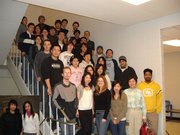07-401/Class Notes for April 11: Difference between revisions
From Drorbn
Jump to navigationJump to search
No edit summary |
No edit summary |
||
| Line 2: | Line 2: | ||
{{In Preparation}} |
{{In Preparation}} |
||
The goal of today's class is to prove |
The goal of today's class is to prove a (weak but strong enough) form of the '''Fundamental Theorem of Galois Theory''' as follows: |
||
'''Theorem.''' Let <math>F</math> be a field of characteristic 0 and let <math>E</math> be a splitting field over <math>F</math>. Then there is a correspondence between the set <math>\{K:E/K/F\}</math> of intermediate field extensions <math>K</math> lying between <math>F</math> and <math>E</math> and the set <math>\{H:H<\operatorname{Gal}(E/F)\}</math> of subgroups <math>H</math> of the Galois group <math>\operatorname{Gal}(E/F)</math> of the original extension <math>E/F</math>: |
'''Theorem.''' Let <math>F</math> be a field of characteristic 0 and let <math>E</math> be a splitting field over <math>F</math>. Then there is a correspondence between the set <math>\{K:E/K/F\}</math> of intermediate field extensions <math>K</math> lying between <math>F</math> and <math>E</math> and the set <math>\{H:H<\operatorname{Gal}(E/F)\}</math> of subgroups <math>H</math> of the Galois group <math>\operatorname{Gal}(E/F)</math> of the original extension <math>E/F</math>: |
||
Revision as of 14:40, 4 April 2007
| |||||||||||||||||||||||||||||||||||||||||||||||||||||||||
In Preparation
The information below is preliminary and cannot be trusted! (v)
The goal of today's class is to prove a (weak but strong enough) form of the Fundamental Theorem of Galois Theory as follows:
Theorem. Let be a field of characteristic 0 and let be a splitting field over . Then there is a correspondence between the set of intermediate field extensions lying between and and the set of subgroups of the Galois group of the original extension :
The bijection is given by mapping every intermediate extension to the subgroup of elements in that preserve ,
and reversely, by mapping every subgroup of to its fixed field :
Furthermore, this correspondence has the following further properties:
- It is inclusion-reversing: if then and if then .
- It is degree/index respecting: and .
- Splitting fields correspond to normal subgroups: If in is a splitting field then is normal in and .


















![{\displaystyle [E:K]=|\operatorname {Gal} (E/K)|}](https://wikimedia.org/api/rest_v1/media/math/render/svg/65c44a48df52c6cd4e1cf197de461b438c3270fd)
![{\displaystyle [K:F]=[\operatorname {Gal} (E/F):\operatorname {Gal} (E/K)]}](https://wikimedia.org/api/rest_v1/media/math/render/svg/93e40beb2ae7daa66244aff7daefbafd6cdeabf6)

